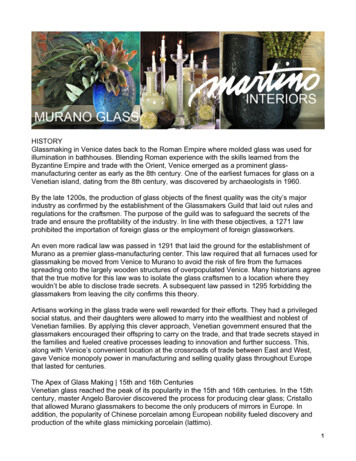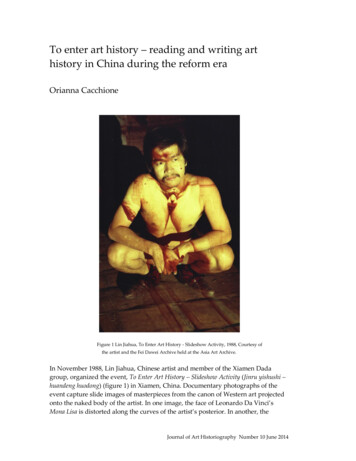
Transcription
HISTORYGlassmaking in Venice dates back to the Roman Empire where molded glass was used forillumination in bathhouses. Blending Roman experience with the skills learned from theByzantine Empire and trade with the Orient, Venice emerged as a prominent glassmanufacturing center as early as the 8th century. One of the earliest furnaces for glass on aVenetian island, dating from the 8th century, was discovered by archaeologists in 1960.By the late 1200s, the production of glass objects of the finest quality was the city’s majorindustry as confirmed by the establishment of the Glassmakers Guild that laid out rules andregulations for the craftsmen. The purpose of the guild was to safeguard the secrets of thetrade and ensure the profitability of the industry. In line with these objectives, a 1271 lawprohibited the importation of foreign glass or the employment of foreign glassworkers.An even more radical law was passed in 1291 that laid the ground for the establishment ofMurano as a premier glass-manufacturing center. This law required that all furnaces used forglassmaking be moved from Venice to Murano to avoid the risk of fire from the furnacesspreading onto the largely wooden structures of overpopulated Venice. Many historians agreethat the true motive for this law was to isolate the glass craftsmen to a location where theywouldn’t be able to disclose trade secrets. A subsequent law passed in 1295 forbidding theglassmakers from leaving the city confirms this theory.Artisans working in the glass trade were well rewarded for their efforts. They had a privilegedsocial status, and their daughters were allowed to marry into the wealthiest and noblest ofVenetian families. By applying this clever approach, Venetian government ensured that theglassmakers encouraged their offspring to carry on the trade, and that trade secrets stayed inthe families and fueled creative processes leading to innovation and further success. This,along with Venice’s convenient location at the crossroads of trade between East and West,gave Venice monopoly power in manufacturing and selling quality glass throughout Europethat lasted for centuries.The Apex of Glass Making 15th and 16th CenturiesVenetian glass reached the peak of its popularity in the 15th and 16th centuries. In the 15thcentury, master Angelo Barovier discovered the process for producing clear glass; Cristallothat allowed Murano glassmakers to become the only producers of mirrors in Europe. Inaddition, the popularity of Chinese porcelain among European nobility fueled discovery andproduction of the white glass mimicking porcelain (lattimo).1
Other types of glassmaking techniques became popular such as enamelling and gilding glass,which originated in the Middle East, filigrana glass which is made using glass rods with innerthreads of white, golden or colored glass that are twisted or intersecting, and ice glass whichappears finely crackled. Variety of shapes and colors increased, and glassware became moresophisticated though the beauty was still viewed as the simplicity of shapes and ornaments.17th Century and the Slow Decline of Venetian GlassDuring 17th century, Murano glass entered the period of gradual decline. As Venetian powergrip on trade routes and its importance as a major center of commerce began to vanish, so didits monopoly power in glassmaking. New centers of the craft emerged in Bohemia, England,and France. Yet 17th century still saw innovation in Murano glass as new techniquescontinued to emerge driven by strong baroque trends that spread through Europeanarchitecture, painting, interior decoration, and other art and craft forms.Brightly colored, intricate glass decorations with floral and animal motives became popular.New glass techniques included avventurina (metal flecks embedded in glass for a sparkly look)and calcedonio (illusion of semiprecious stones), raised decorations on glass, and millefioribeads. These new techniques were so successful that even royal courts ordered glasswarefrom Murano artisans. One example is King Frederick IV of Denmark who in early 17th centurypurchased a glass collection that is currently on display at the Rosenborg Palace inCopenhagen.The Fall and the Rise 18th and19th CenturiesIn the 18th century, the decline continued and was aggravated by worsening political climateand increased competition from the glassmakers in Bohemia and France. Some newtechniques were introduced, such as engraving on glassware and mirrors, but they did notmake visible impact. The industry shrunk drastically with Napoleon’s conquest of Venice in1797 and his abolishment of all of Venice’s guilds, including the Glassmakers.In 1814, the transfer of Venice from France to the Habsburg Empire spelled the ultimate deathsentence to Murano glassmaking as Habsburg rulers preferred their native glassmaking centerin Bohemia and passed laws making it prohibitively expensive to bring necessary rawmaterials into Murano and export the final product. As a result, almost half of the 24 furnacesthat existed in Murano in 1800 shut down by 1820, and only 5 furnaces continued to produceblown glass. However, against all odds, the industry didn’t die completely ? it was kept alive bythe artisans’ personal dedication to their centuries-old craft and their father’s hard work thatonce made Murano glass world famous.The breakthrough came in 1854 when six Toso Brothers opened the firm Fratelli Toso thatinitially produced household glass items and window panes but then switched to revivingforgotten techniques of the past. Five years later, Antonio Salviati came to Venice fromVicenza where he practiced law to open a factory dedicated to production of traditional Muranoglass. He saw an opportunity to revive the craft by producing tiles that could be used to restoreold Venetian mosaics, and he hired the best Murano masters to work in his factory. One of hisglassblowers, Lorenzo Radi, spent much time during Austrian rule rediscovering the oldmethods and techniques that were used to create old Venetian mosaics.2
Salviati’s plan worked, and Venetian authorities soon signed a fifteen-year contract with hisfirm for restoration of the mosaics in St.Mark’s basilica. At around the same time, in 1861,Venice mayor Antonio Colleoni and abbot Vincenzo Zanetti decided to compile an archivededicated to the history of Venice containing not only various writings but also objects of artproduced in the city. Gathering of the objects for the archive caused renewed interest inVenice’s history, its past glory, and its famous crafts including glassmaking. This in turnprompted officials to set up a school for glassmakers where they were able to learn again theforgotten techniques and secrets of the craft.The culminating event in reviving Murano glassblowing was the exhibition set up by theArchive in 1864 to display all the recent glass works and reignite competitive spirit among thecraftsmen. On the heels of that exhibition were other international shows, such as the highlysuccessful Universal Exposition in Paris in 1867 where Salviati exhibited over 500 works madeby his firm and received international acclaim and multiple medals. This success and publicityled to complete revival of Murano, which once again became a booming economic center,employing 3,500 people by 1869, and a famous destination.20th Century - New Identity and the Art of Murano GlassIn the beginning of the 20th century, the master glassmakers of Murano were still enamoredwith reproducing classical styles and rediscovering ancient techniques, which was evident atMurano and Venice Exhibition of Choice Glass and Glass Objects staged in 1895 insideMurano City Hall. The rules of the exhibition dictated that the works showcased bereproductions of antique glassware. This important event was well attended by internationalcollectors and glass admirers who greatly appreciated the works rooted in unique Muranotradition.The best works of Murano artists were on display; many were a product of an importantglassmaking technique called Murrino (mosaic), which was rediscovered at the end of the 19thcentury by Vittorio Zuffi while working for Fratelli Toso. This technique originally emerged in the16th century in an effort to imitate ancient Roman vases. Murano’s famous firm Artisti Barovierreceived the Honorary Diploma and the Gold Medal. Other artists enjoying popularity inMurano at the time were Salviati, Testolini, and The Toso Brothers (Fratelli Toso).The year 1895 was also the time of the first Venice Biennial exhibition where new works of artin avant-garde and art nouveau styles were showcased. This highlighted the gap between themodern trends gaining strength in Europe at the time and the works of Murano artisans whowere deeply attached to the styles and methods of the past. This gap became even moreobvious at the Universal Exposition in Paris in 1900, followed by Expositions of Decorative Artsin Turin in 1902 and Milan in 1906. Some Murano artisans, like Vittorio Toso Borella, becamereceptive to the new winds blowing on the art scene and started to produce works in artnouveaustyle. Though he originally got mixed reviews for the works he exhibited at Ca’ Pesaroin 1909, Vittorio went on to produce masterpieces that later became universally appreciated.Ca’ Pesaro, unlike Venice Biennial, became an exhibition embracing new artistic trends andshowcasing many works in art vouveau style by young artists such as Gino Rossi, ArturoMartini, and Guido Marussig. One of the artists, Vittorio Zecchin, collaborated extensively withArtisti Barovier to create designs for their famous glassware.In the 1920s, art nouveau slowly got replaced by more modern styles with simpler, cleaner,and more functional designs. Art deco took the center stage and with it came less decorated3
objects with softer lines and more focus on glassware as part of interior design, not a piece ofart in and of itself. A new company, Vetri Soffiati Muranesi Capellin Venini, founded in 1921under Vittorio Zecchin as its head designer became the champion of this style.A little later, in the late 1920s to early 1930s, another important trend arose in Murano led byMaestri Vetrai Muranesi Capellin & Co. and Vetreria Artistica Barovier. The trend was glassanimals, which remain popular even today. Other important innovations championed in 1930sand continued in early 1940s were production of glass statues of female nudes and classicalfigures of boxers and gods, engraving on glass, modern lighting fixtures, perfectly proportionedtransparent glass tableware, and the invention of vetro sommerso ? a technique allowing toproduce thick glassware with one color on the outside and another on the inside.During World War II the industry did not thrive, but as soon as the war was over the glassmasters of Murano returned to their art and created pieces deeply rooted in interior designtrends of that time with focus on minimalism, functionality, and simplicity. To support thesetrends Murano artists and artisans returned to techniques of the past such as filigree, murrino,and lattimo. From that point onwards Murano saw continued exploration of styles andtechniques striving to find a happy medium between the technical mastery and the outline,color, and decoration.The resulting continuous innovation led to a rise in popularity and to multiple prizes at variousinternational art exhibitions. Thanks to such prominent artists as Archimede Seguso, Ludovicoand Laura De Santillana, Tobia Scarpa, Ercole Barovier, Fulvio Bianconi, Toni Zuccheri,Romano Chrivi, Giampaolo Martinuzzi, and Alfredo Barbini, Murano again became known asthe glassblowing capital of the world. Murano now created the art trends as opposed tofollowing them in the years past.Murano Glass TermsGlass is a solid matter which, in its raw state, is made of siliceous sand, soda, lime andpotassium melted together in an oven at a temperature of 1500 C, to become a flexiblematerial. Then, in the simplest scenario, the glassmaker removes this substance from the ovenwith the help of a pipe, and shapes it using various specialized instruments that changed littlesince antiquity, such as pliers, scissors and wooden shovels. "Glass-blowing" refers to amethod of blowing inside the pipe to give the glass object a form.The magnificent appearance and coloring of Murano glass is achieved by adding gold or silverfoil to the glass mixture and/or adding minerals such as zinc for white, cobalt for blue,manganese for violet, and so on. Once the object is finished, it is placed in a cooling oven,called "tempera", to cool down slowly; in this way it doesn't break due to the extreme variationsin temperature.AVVENTURINAClear glass that features metal particles embedded into it to create a shimmery, sparkling look.The particles are made out of copper or other metal oxides. This manufacturing process is verydifficult, and has been invented in the seventeenth century. It is said that avventurina glasswas invented by accident when a Murano glass maker spilled copper filings into the glass hewas working. The glass that resulted from that lucky occurrence was named avventurina - fromItalian word "ventura" (translated as "fortune" or "chance").4
BULLICANTEGlass which is decorated with a regular pattern of evenly spaced air bubbles that becomegradually larger or smaller. This widely used art glass technique was especially popular withMurano glass artists during the 1950s.CHALCEDONY CALCEDONIOGlass featuring polychromatic veins running through the dark-colored glass. This look isobtained by mixing various metal compounds in a certain fashion, to imitate the natural stonessuch as chalcedony, agate, and malachite. It was known and used in ancient Egypt, and thenre-discovered in Murano in the fifteenth century. The secret of the technique was then lostagain and subsequently re-discovered by Lorenzo Radi in the later part of the 19th century.CAMEOExtraordinarily difficult technique which consists of first fusing two glass layers of differentcolors, and then raised-carving the object to create a design based on revealing portions of theunderlying colors . The first known examples of the use of this technique date back to firstcentury A.D. One of the best known examples of this technique is The Great Tazza - anelaborate ornate bowl that is based on five layers of different colored glass. The piece waspresented to much amazement at the 1990 Paris International Exhibit.CRISTALLO VENETIAN CRYSTALVenetian crystal is the first truly colorless glass, invented in 1450 by Venetian glass masterAngelo Borovier, and obtained by bleaching glass mixture using manganese or otherdecolorants. It is a fragile sodium-based glass, and is best suitable for manual etching.FENICIO PHOENICIAN'Fenicio' (Phoenician) is a technique used to produce festooned motif on glass. It was adoptedin Murano at the end of the 17th century, though it was used on glass as far back as the 2ndmillennium AD. The glassworker wraps the incandescent glass threads with a thin pontil, or"speo", and then while the object is still hot, he combs the threads with a hooked tool, called a"maneretta". Then, once the threads are merged into a single piece of glass, the obtaineddecoration is similar to festoons or feathers.FILIGRANA RETICELLO or A RETORTIFiligrana is a name used to describe several techniques to create glass formed by colorless orwhite rods with inner threads of white, golden or colored glass. The technique is called"reticello" when the threads cross and form a grid, where small air bubbles form in between thethreads. Glass is called "a retorti" or "retortoli" when threads form a spiral pattern and do notcross. This technique has been in use since the sixteenth century.GHIACCIO ICE GLASSThe term comes from the Italian for "ice". This kind of glass appears cracked on its entiresurface. This effect is obtained by immersing still hot shaped glass object in cold water andthen covering the crackles with another layer of glass. It was very popular from the 16th to the18th centuries. This results in a finely-crackled glass surface similar to cracked ice.INCALMO5
An ancient glass technique requiring a particular dexterity from the master performing it. It isused to create objects formed by separate parts blown one at a time, usually of differentcolors, and then joint together while still warm, and shaped to the desired form.LATTIMO From Italian "latte" - milkOpaque white glass produced for the first time in Murano in the fifteenth century, imitating thelook of fine china. It was originally used for manufacturing objects decorated with multicoloredenamels.MILLEFIORI aka MURRINE(From Millefiori - "a thousand flowers"). The basis of this technique is the use of glass canes(rods) which contain a single flower design visible only on the surface of cross sections of thecane. The object is then formed using the cross-sections of multiple such rods, which aremelted together to cover the surface of the glass object. This technique was first used in Egyptbetween the third and the first century B.C.SOMMERSO(From Italian "Sommerso" - submerged). Creates a layered appearance where one coloredlayer of glass is covered by another layer of differently-colored glass. This effect is achieved byrepeatedly dipping a glass object into molten glass of another color. This technique wasinvented in Murano in 1930's.6
The industry shrunk drastically with Napoleon's conquest of Venice in 1797 and his abolishment of all of Venice's guilds, including the Glassmakers. . As a result, almost half of the 24 furnaces that existed in Murano in 1800 shut down by 1820, and only 5 furnaces continued to produce blown glass. However, against all odds, the industry .










